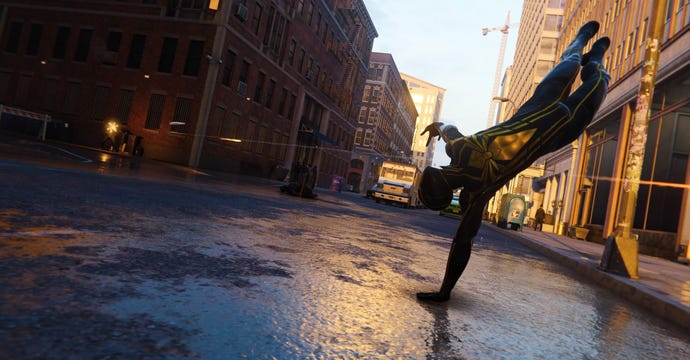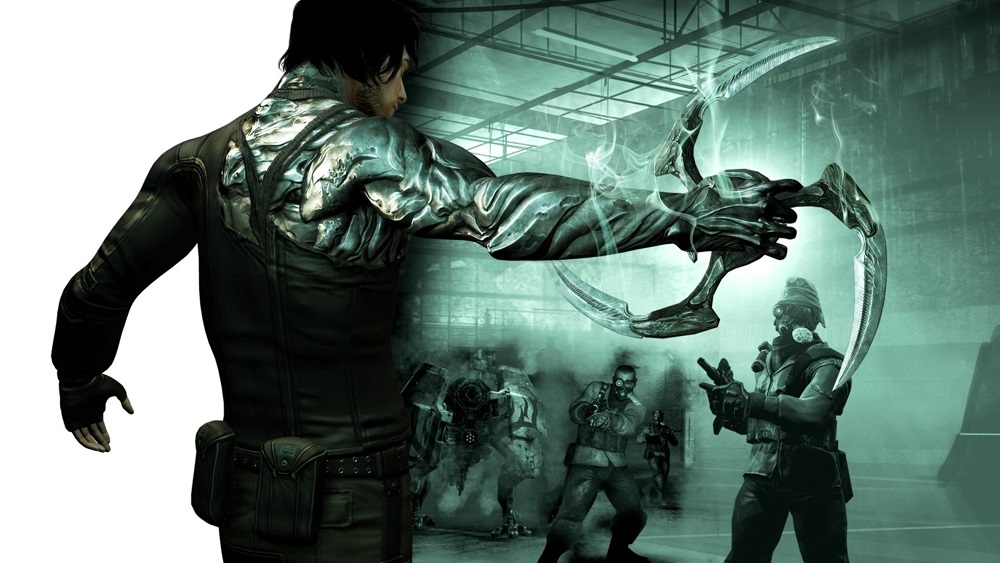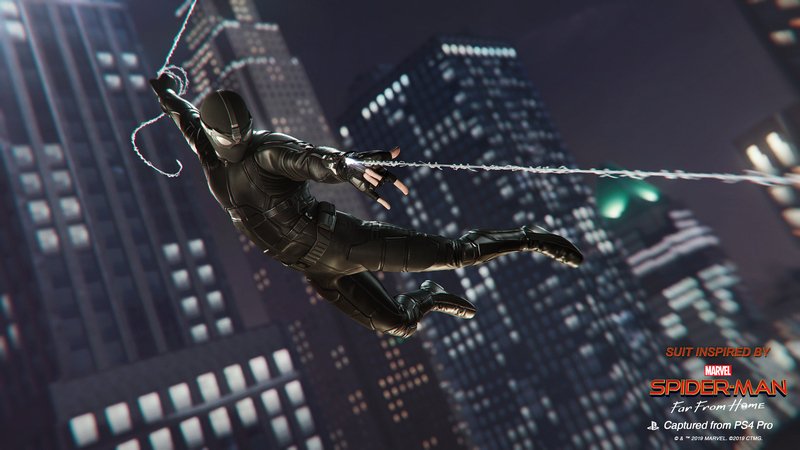An ode to the unsung heroes of video game cinematics and gameplay - stunt performers
“I was never a person who wanted to be set on fire,” Richard Dorton, a mocap actor and stunt performer who works in television and video games tells me, as if we’re talking about how he takes his coffee. “I used to do car stuff. Crash cars.”
If you want to get into stunts and not self-immolate, video games are a good bet. When you’re set on fire in a video game, there’s no need for you to actually be on fire - you just need to flail around the motion capture volume, the space where every movement is recorded and captured, and pretend you are.
“Mocap is pure imagination,” Dorton tells me. “If you’re willing to scream, spit, cry on film and TV, you still have to be able to do that in the mocap volume. Sure, you’re not going to be setting me on fire, but I need to show pain, I need to be able to emote and bring those kinds of emotions out. It’s still acting.
“I have cried, I have snotted, I have done everything I’m supposed to do in that kind of situation. I take what I do very seriously, and I think when you watch a cinematic that can move you, like from The Last of Us, or God of War, that’s us committing to our art. You go for it. Look, I got punched in the face, got my nose broken on Uncharted: Golden Abyss.”
Dorton played the body double for Nathan Drake for his PlayStation Vita adventure. If you see Drake clambering, falling down, or fighting with goons, that’s all Dorton, while actor Nolan North handled the rest. “But you’re also acting,” he says. “So on top of just doing the move, I have to do the move as Nathan Drake. I’m not just climbing a fence, I’m climbing a fence as Nathan Drake. And he’s an everyman. He’s a little sloppy. So you have to take that into consideration in your performance.”
This particular scene was a fight sequence which saw Dorton paired with a mocap actor who wasn’t trained in stunts, despite his protests. Dorton tackled him to the floor and threw two fake punches at him, grounding and pounding. The actor responded with a punch of his own, straight up from his position on his back - smacking Dorton’s nose.
“I’ve broken my nose like three times, so I knew it was broken. I knew what to do. I just said, “Give me a half hour,” I walked to the bathroom, saw it was over here,” Dorton says, smushing his nose across his face, “and I moved my nose back, basically.”
One of the other times he broke his nose, it was from an elbow during a self-defence class. Many stunt and mocap performers are trained in martial arts, which helps with their combat scenes. The second time, it was from a light switch someone had unplugged - it swung down from the rafters at the top of the mocap volume. The thing would have hit him in the back of the head if he hadn’t turned to see what that whooshing sound was. Smack!
As any pro wrestler will tell you, even simulated combat is dangerous. It’s the same for stunt performers in video games - especially when they’ve been working a full, exhausting shift. It’s an extremely physical job, people get tired, and sometimes tiredness makes people sloppy.
“I got elbowed in the temple by a stuntman,” Dorton remembers, raising his hand to his temple like he can still feel the throb. “We were doing a big fight scene and his martial arts background kicked in to self-defence. He wasn’t thinking about the choreography, he was thinking, ‘Here comes this punch!’ And he just blocked it and threw his elbow. Tapped me right in the temple. It’s five o’clock in the evening, you’ve been shooting for ten hours, you’re exhausted, you can make one wrong move, or forget a punch for the choreography.”
In movies, actors and stunt coordinators sometimes spend more time waiting than they do performing. In video games, the developers have allocated X amount of time and they plan to capture X amount of data from the shoots. That means it’s non-stop once things kick off. Just think of how much crouch-walking your average video game protagonist does and imagine how that makes your legs feel towards the end of your day. If Solid Snake were real, he’d probably take many trips to a chiropractor.
Dorton might not be getting set on fire, but these shoots do take a toll. If you’re playing a shooter and your character gets knocked down, there’s a good chance a stunt performer did that. And they have to jump straight back up, because that’s what the player expects as soon as they press an input on the controller - their character to spring immediately to their feet. They fall down, they get back up. They fall down again and they jump back up. All day.
Now in a movie, you might be falling onto concrete. For that, the stunt performers use pads to cushion the blow and help prevent road rash. On the surface, mocap studios are safer, since you always can land on a mat. However, you can’t wear pads with a mocap suit. Oh, and you’re often purposely landing directly onto your face.
“Falling down on your face hurts, even on a pad,” Dorton laughs. “You still get rattled sometimes. Or you’re falling off the scaffolding, even falling five feet, rolling off of something and hitting the ground, and then you’ve got to get up - that stuff wears and tears on your body. If you do get injured, it can take you out, depending on the severity. I rolled my ankle, I’ve torn my calf muscle, you know, rotator cuff, just from full-on motion fighting. I had a speed rail strapped to my arm, because I was playing a character who had his arm morphed into a spear. So you’re throwing this around and thinking about punching, punching, punching, constantly. Five hours in, you’re exhausted and you throw too hard, and you’ve jacked your shoulder up.
“You’re getting killed with a knife. Then you’re getting killed with a handgun. Then a rifle. Then a shotgun. Then a chainsaw. So every weapon that is being used in a game, you’re being killed with. So you’ve got to do all those deaths with that. A move list for a video game, thousands of moves, right? From turning the doorknob, to walking, to every death with every different type of weapon. So a video game takes two years to make. I will shoot a mocap for three days, and then six months later come back and do one day, and then two months later come back and do two days. So it’s spread out over those two years, I could work anywhere to one day to ten days or fifteen days. At some point, if you’re a good, working, consistent mocap performer, you’re going from one game to the next game to the next game.”
When it comes to stunts such as performing a five foot fall from scaffolding onto his back, Dorton has the advantage of experience. He knows to tell the director that he wants to try to do it in one or two shots, not keep repeating the fall, therefore increasing his chance of injury. It’s the same with those crouches and deaths - he’ll ask for those to be saved until the end of the shoot so he can, you know, move his legs for the rest of it. Though the industry is improving in this regard, sometimes, like when Dorton was punched in the face, mocap actors who aren’t trained in stunts will be asked to perform something potentially hazardous.
“If you're not careful, you'll get normal actors being asked to do things that may become dangerous,” mocap and VO actor Noshir Dalal explains. “Having a crew on-hand that recognises the difference and is willing to say, ‘Let's do that on a stunts day,’ is super important. Sony is really good about that, but other motion capture studios I've worked with are not. When the mocap stage doesn't stand up for the actor, that puts the onus on the performer, and it can be very difficult to say, ‘No, I don't feel comfortable with that.’ As performers, me and my mocap peers want to do a great job - we pride ourselves on our work. And it isn't uncommon for a seemingly simple action to quickly become a very difficult or even dangerous situation without folks realising it.”
It’s something actors union SAG-AFTRA also feels strongly about, too. “In performance capture, it’s always important to have qualified stunt coordinators on-site to choreograph and ensure the safety of stunt work,” a SAG-AFTRA spokesperson tells me over email.
When Dorton works as a stunt coordinator, he has his own approach to making sure the directors and animators understand what’s being asked of the stunt team. During one game, he was tasked with running full speed towards some barrels, since we all know video games love barrels, and clearing the top of them with a jump. Except he wasn’t being asked to clear them - he was being asked to purposely catch them mid-jump with his foot, trip, and fall into a crash mat.
“You’re just face-planting,” Dorton explains. “It’s a mat, but it still hurts. Usually I will tell the director, because I had to do this to a director, I went, ‘Show me what you want?’ They’re like, ‘Oh, it’s a pad! You can fall down.’ So they’ll show me one time, you’re running, they trip, they hit the mat, and they go, ‘Oh, ow.’ And I’m like, ‘See? This is what you’re doing to my body all day long, so you have to understand, I don’t want to do it ten times. I’ll do it one time for you, or two times. But this is what you’re putting me through.’ You don’t want to do crazy stunts like that first off, because then if I get injured, we’ve lost the whole day.”
Apparently the secret to successfully landing on your face is to turn your head to the side at the last minute and take the force of it on the cheek. It sounds fun, in the same way stubbing your toe is fun. Oh, and because this is a video game shoot, they often land on the hard side of the crash mat. “If you’re on a sponge, it’s harder to capture that,” Dorton tells me, using his hands to simulate the shifting weight of feet squishing into a crash mat. “So you stand on the hard side of the mat, you have a little bit more balance, and it looks better for the character. You just have to go for it. That’s part of the job. Oh my God, here we go again, shotgun blast to the face. You just go for it, and you don’t throw your hands out to catch yourself, you know to roll your shoulder a little, you want to turn your head and just crumple.”
Tom Keegan, the performance director for Wolfenstein 2, Resident Evil 2, and Star Wars Jedi: Fallen Order, is also aware of the importance of stunt work.
“Stunt performers are a very, very big part of any game, really any game,” Keegan explains. “It’s great if an actor can do their own stunts, but sometimes we actually don’t want them to, because if they get injured in any way, it’s going to be really, really hard. And I have seen injuries on the set.
“There was an actor who had to do a scene where he was trapped in amber, and another actor had to come and cut him out of that with a lightsaber. And he had to do it over and over - he just had to kind of fall down with his legs together and fall to the ground. This is a very athletic, very in-shape actor, but something tweaked in his knee and he had to have surgery. I’ve seen an actor, she was doing a stunt, run and jump into a craft - you know, it’s a little wooden set, but kind of a spacecraft - and just miss by a few inches and wreck her knee. It can be the smallest thing, someone jumping down off a stool. Some companies actually insist that actors not do any stunts.”
Part of the reason actors and directors sometimes aren’t aware of the dangers, however, is inexperience. After all, video games haven’t been around as long as movies, and the technology is moving faster than most people can keep up with. It makes it difficult for everyone to have a grasp of every aspect, and that’s why there needs to be someone on set like Dorton who has the authority and knowledge to say no. But there’s still a long way to go before stunt performers aren’t an afterthought for many projects.
“I think, when a game is being developed and created, if stunt coordinators were brought on in the beginning of that process, when all of that stuff is included in the budget of the game, then it would be a lot easier,” Dorton explains. “They’ll spend six months working on the design and the maps of the game, and what gameplay is, the technical stuff, and then it’s like, ‘Oh, we need to do a mocap shoot. What’s in the budget? Oh, that hasn’t been created ahead of time.’ And then you go, ‘Well, we need swinging, so we’re going to need wire work, and we’re going to need rigging.’ And when you’re doing wire work, you’ve got to have a coordinator, you’ve got to have people pulling, you know, so those are stunt guys who are doing all the rigging, who are doing all the hand pulls and the winches and stuff like that. Those are stunt guys as well, so you should be paying them well.”
The pay isn’t always as much as you would think, though. Dorton tells his students that they’ll be doing well if they book one job per year, and a day rate for a job might be in the region of $1,000, but that’s maybe 18 shoots spread out over the course of two years. All-in, you’re looking at $36,000, plus health insurance, for that period, if you’re lucky enough to book a job both years. In movies, this shortfall is made up with bumps. Dorton told me about a certain parkour expert on a movie he was working on, who was bringing in the region of $7,000 for each rooftop he cleared, only to jump to a fire escape at the end, where his leg exploded upon impact, slipping in the rain and breaking his ankle, putting him out of work. While they might not make up for a horrific injury such as that, these pay bumps for dangerous stunts don’t even exist in video games.
“You should get a bump,” Dorton says. “Let’s say I’m going to go on a movie set for a day, and it’s a big crowd scene, and I have to run and fall down. So I’m going to get my [union standard] SAG [pay] scale - I’m going to get that rate. And maybe if I fall over a table, the stunt coordinator’s going to give me an extra hundred bucks for that. So that’s built in, into the movie budget. For a video game, it’s like, ‘Oh, today we’re doing Spider-Man, and they’re going to be swinging and throwing people around, and they’re going to do as many moves as they can,’ or, ‘We have four cinematics we have to capture today that have a bunch of fight scenes in them.’ That’s just one flat rate and you do it all. So there aren't any adjustments. If you take the job, that’s what you’re agreeing to.”
You take the bumps, but you don’t get any - that’s video game stunts in a nutshell. But these performers keep going. They get knocked down and they get back up again. They break their noses, tear their tendons, and twist their ankles, and they do it all for you.
For more like this, check out the rest of our articles in our week for actors.












_ddwYK80.png?width=291&height=164&fit=crop&quality=80&format=jpg&auto=webp)


